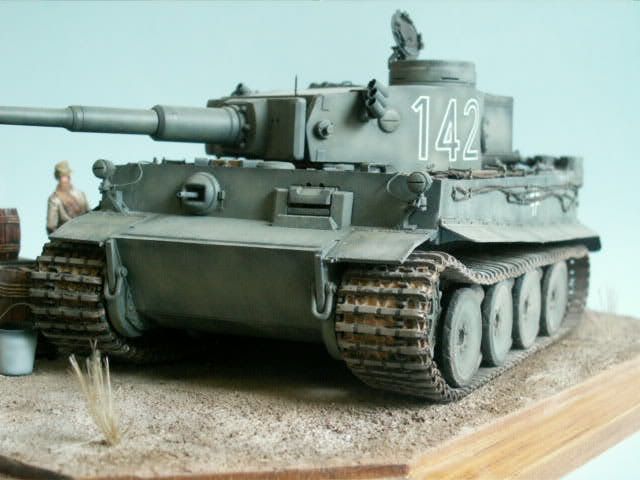I don’t see much evidence of a “cammo” patternin these B&W’s but, one can draw thier own conclusions?
Good pics, SC. Did you note what look like a row of water-filled Jerry cans acrosss the top of the turret in pic #4? Cool!
Here’s some of the conclusions I’ve drawn so far.
There is much to support that camoflage was not applied at all in Tunisia, and where it was, it wasnt strongly disruptive. This was the beginning remember, the first of the Tiger deployments and encounters. The DAK/PK weren’t really fearful of other tanks once they got the Tiger into combat. Stories still circulate about the then-powerful French 75MM antitank guns that simply bounced off the Tiger’s hull…from 50 meters! Or the standard rule of the time that it took 5 Allied tanks to even slow a Tiger… if you could get close enough…which you couldn’t! This is partly where the Tiger’s aura of invincibility was born (No one had learned the major flaws in the design, yet).
So, from the DAK/PK’s viewpoint at the time, why would you need to get carried away with camo’ing an “invincible” tank? There just wasn’t a huge need to blend into the background, like there would be in later years. In all the pics of Tunisian campaign Tigers, there is very little done along these lines. The only exception was meaningful air attack, and I don’t believe the Allies had that well figured at that early stage. Planes armed with effective rockets and cannon were still in the future.
Factory issue color was Dark Gray (RAL 7027), remember, at this stage of the war. In fact, it was a recommended camo color, if youll recall. The Germans hadn’t gone to good old Dunkle Gelb yet. Some tanks were issued from the factory in theatre colors, and even in the Red-Oxide primer in use at teh time. But, most deploying units repainted their gray mounts in-theatre (or enroute), with supplied stocks of replacement theatre-specific base color, and whatever else was available, I suppose. This lends credence to the use of American OD paint, once the Yanks were scampering out of the way of the DAK/PK and the Krauts got their hands on it.
Besides, there were no set patterns for camouflage, anyway - that wouldn’t happen until 1944. The Germans were still on the offensive, and field units were simply authorized to use certain colors as needed. It was really quite arbitrary, even discretionary, and from what I can tell, rather cavalier. Those were heady times for the Wehrmacht.
Taking this BTT and my original post, here’s what I’ve come up with so far on the colors themselves. My butt is about tired from all the looking, “but” I finally found some useful color references for the rather obscure, early DAK/PK RAL colors:
RAL 8020 - Very close to the Bodington example, what I would call a “caramel-like” tan.
RAL7008 - Similar to the Bodington example, what I would call a dark khaki-brown/green. Similar to a well thinned American OD.
In this case, both the Bodington Tiger and the back cover of the Squadron book look pretty danged close.






